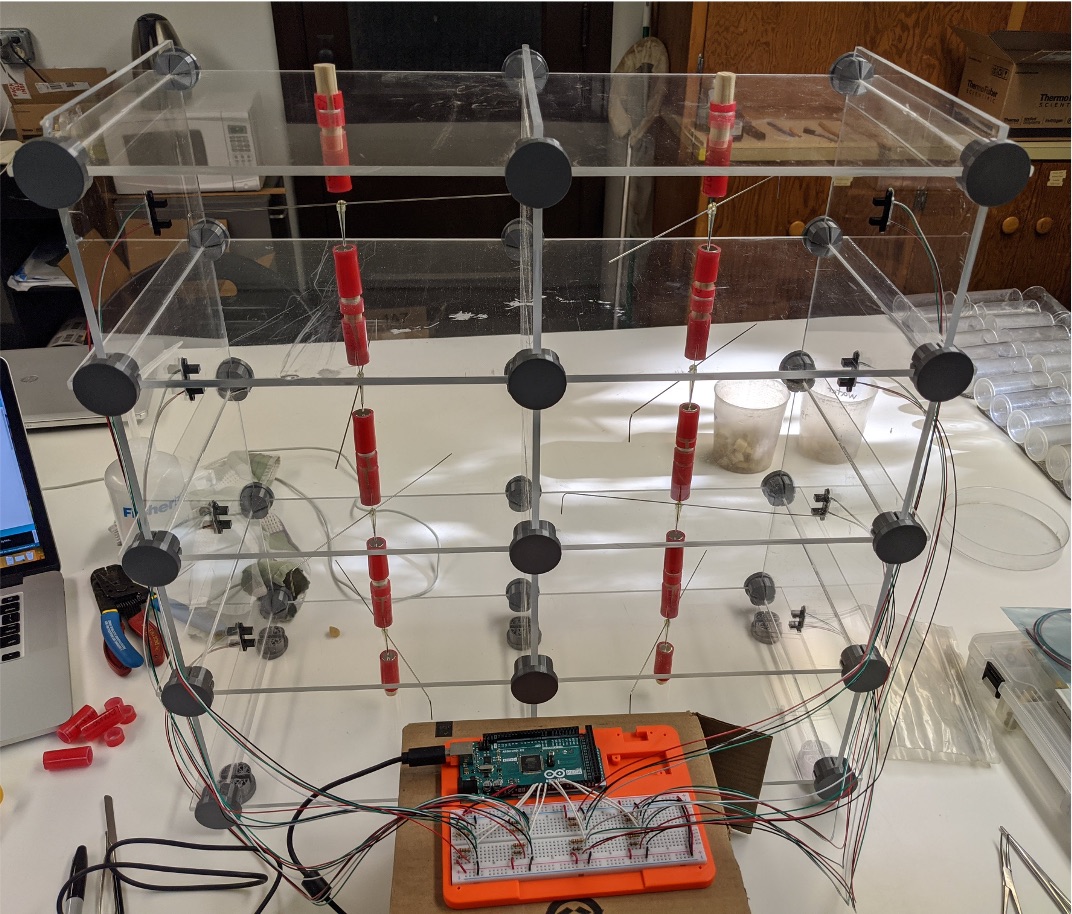Master's Research Fall 2020
The day has not yet dawned as I ready my lady bugs for their first flight. I spent most of the previous day carefully dabbing small dots of
magnetic paint to their shells right by a convenient triangle of black spots. I hope that the tedious hours readying the magnets and the paint
will lead to solid attachment to the flight mill I’ve rigged up. If all goes to plan, I will complete sixty-four 3 hour flights in the next 12
hours and I am slightly nervous. I haven’t yet collected any data with my scratch-built flight mill. Each beetle will be stuck to a rotating
arm with small infrared sensors to log each revolution. All the beetles were reared from eggs by my hand, the product of nearly two whole months
of meticulous feeding, maintenance and care. This is the first time I have actually relied upon my little construction for real data collection,
and I would hate to fail now.
I became interested in flight purely as a means to study energy tradeoffs in insect behavior. The interplay between reproduction and flight can
help growers to plan out planting patterns for fields across landscapes. Creating an ideal pattern across a whole landscape would allow insects
to concentrate their efforts on predation and feeding, increasing the ecosystem services and protecting crops from potential pest damage.
I’m using this flight apparatus like a treadmill to see how many calories lady bugs burn while flying. What surprises me is how much I
love watching them fly. Insect flight is a complicated affair, interacting scaffolds within the insects body flex and snap, flicking the
lightweight wings back and forth, similar to a bored student drumming a pencil between two fingers. The armored plates that comprise the
body of the beetle pump against each other and drive high frequency wingbeats using very thrifty muscle movement. Their highly efficient
flight strategy means that some insects can traverse whole continents. Monarchs are the poster child for that particular feat here in
North America, but many other insects also achieve impressive distances.
Though by beetles are tethered to a rotating arm that is only about 10 centimeters long, they can really build up a head of steam!
Beetles look unique in flight, their ‘shell’ is actually a pair of hardened outer wings that they must hold forward out of the way of
their longer hindwings. When the beetles attach to the magnet their hardened wings lift like the doors of a Lamborghini and their
hindwings snap out to their full length. Initially the beetle fights against inertia, slowly moving forward, once they overcome this
however the beetles can complete a full circuit in an almost comically short period of time. Their speed is not the only impressive
characteristic of the flight, often when I open the door to the flight mill, I find my girls still merrily whizzing around, not having
slowed at all. Obviously, they could easily fly longer than I have allowed for in this study. It’s astounding to think that an insect
that fits under my thumb nail can travel over 4 thousand meters in the course of 3 hours. How can they possibly carry enough fuel for that?
And perhaps more exciting, how far could they fly before exhaustion overcame them? Five kilometers? Ten?
Of course, that’s not all they’re doing. The other half of the calorie tradeoff in this study is reproduction. Lady beetles have limited
energy ‘stocks’ and as a result limited capacity to invest in either behavior that is energetically costly. I want to know how energy spent
on flight alters future energetic spending on egg laying, and vice versa. After this first flight I will count how many eggs each female lays
for 18 days, then fly them again. I expect that more flight will lead to fewer eggs. By the end of this experiment, some of these insects
will have flown nearly 9,000 meters and laid around 200 eggs, all under challenging food conditions. It’s certainly more than I have
accomplished under the recent, shall we say ‘challenging conditions’ in 2020.
As we begin to understand the need for real diversity in agriculture and try to recover from the harm done over the last couple
centuries to soils, plants, and insect life, It will be increasingly important that we understand the more invisible aspects of the ecosystem.
We are only beginning to scratch the surface, but I am hopeful that experiments such as these can lead to real effective improvements to
agriculture. For now however, I will settle in for a long day of insect flight. It’s a simple joy to watch the lady bugs go!
Lady Bug Flight Testing

